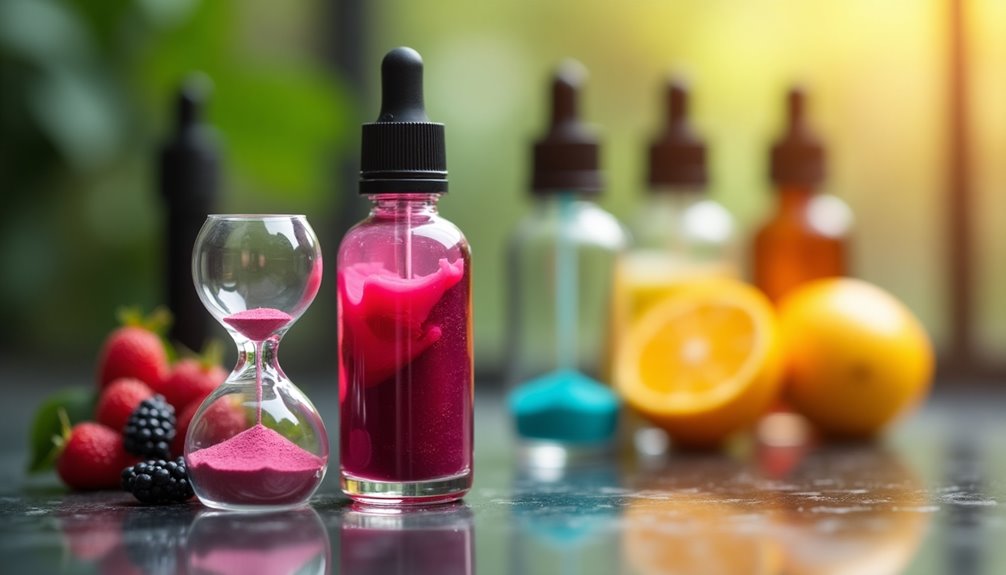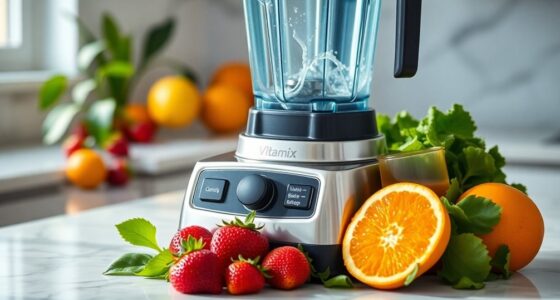E-juice can last anywhere from 6 months to 2 years, depending on whether it's opened and if it contains nicotine. Unopened, nicotine-free e-juice can last 1 to 2 years, while sealed nicotine e-juice typically lasts about a year. Once opened, nicotine-free e-juices should be used within 6 to 12 months, and those with nicotine are best consumed within 3 to 6 months. Want to know how to extend your e-juice's shelf life? Keep going!
Key Takeaways
- Unopened, nicotine-free e-juice can last between 1 to 2 years, while sealed e-juice with nicotine typically lasts up to 1 year.
- Opened nicotine-free e-juice has a shelf life of 6 to 12 months; freebase nicotine e-juice should be consumed within 3 to 6 months after opening.
- Nicotine salts e-juice can last up to 12 months if sealed and stored properly, extending its usability.
- Proper storage in a cool, dark place and keeping bottles tightly sealed can significantly prolong e-liquid quality.
- Regular evaluation for changes in color and smell is essential to assess the freshness and safety of e-juice.

Have you ever wondered how long your e-juice actually lasts? Knowing the shelf life of vape can save you from using expired vape juice that mightn't only taste bad but could also potentially be harmful.
Generally, unopened, nicotine-free e-juice can last between 1 to 2 years. On the other hand, sealed e-juice containing nicotine typically has a shorter shelf life, lasting up to 1 year. So, if you've got a stash of e-juice sitting around, it's essential to check those expiration dates.
Once you crack open a bottle, things change a bit. Nicotine-free e-juice has a shelf life of about 6 to 12 months after opening. However, if you're using freebase nicotine e-juice, you should consume it within 3 to 6 months for the best experience. Nicotine salts e-juice can last a bit longer, up to 12 months, if kept sealed and stored properly.
How you store your e-liquid plays a crucial role in maintaining its quality. Avoiding exposure to light and heat can significantly extend its usability.
It's not just about the time though; monitoring the color, consistency, and flavor of your e-juice is equally important. Signs of expired e-liquid can include a noticeable change in colour or a change in smell and flavor. If you notice your e-juice has turned darker or has developed an off-putting odor, it's a good indication that it may have expired.
Keeping your vape juice properly stored can help prevent these changes. Try to store your e-liquid in a cool, dark place and keep the bottle tightly sealed when not in use to minimize exposure to air.
The nicotine content in your e-juice also impacts its shelf life. E-liquids with higher nicotine concentrations can deteriorate faster, especially once opened. If you're someone who vapes frequently, you mightn't have to worry as much about expiration dates, but for those who might've a few bottles sitting around, checking the signs of expired e-liquid is crucial.
Always be proactive about your e-juice quality. If you're unsure whether your e-juice is still good, take a moment to evaluate it. Look for any changes in color and give it a sniff. If everything appears normal and smells right, you're likely in the clear.
However, if you're ever in doubt, it's better to err on the side of caution and replace it.
Ultimately, understanding how long your e-juice lasts and how to properly store it will enhance your vaping experience. Regularly consider the signs of expired e-liquid, and you'll ensure you're getting the best flavor and quality with every puff.
Frequently Asked Questions
Can You Use 3 Year Old Vape Juice?
You shouldn't use 3-year-old vape juice.
Even if it looks okay, it likely has degraded in flavor and quality.
Check for signs like darkening color, separation, or unusual smells; these indicate spoilage.
While some e-liquids might still be usable, it's risky.
Most manufacturers recommend sticking to the expiration date for the best experience.
Does Vape Juice Actually Expire?
You might be wondering if vape juice really expires. Yes, it does!
While unopened nicotine-free e-liquids can last 1-2 years, those with nicotine usually stay good for about a year.
After that, you may notice changes in flavor, color, and consistency.
Though expired juice might still be safe to vape, it won't taste as good.
To keep your e-liquid fresh longer, store it in a cool, dark place.
How Long Can I Keep Vape Juice?
You can typically keep unopened vape juice for 1 to 2 years, depending on whether it contains nicotine.
Once you open it, nicotine-free options can last 6 to 12 months, while freebase nicotine liquids usually last around 3 to 6 months.
Nicotine salts can last 6 to 12 months if stored properly.
To ensure freshness, regularly check for changes in color, consistency, and smell, and store your juice away from heat and light.
How Long Does 1 E-Liquid Last?
E-liquid's enduring essence depends on its ingredients and storage.
If you've got nicotine-free e-liquid, it typically lasts 6 to 12 months once opened, while nicotine-infused varieties can last 3 to 6 months.
Stored safely in a cool, dark spot, you might extend its lifespan.
Keep an eye on flavor, color, and consistency; those signs signal if your e-liquid's still suitable.
Conclusion
In the end, your e-juice can last anywhere from a few months to over a year, depending on how you store it. Picture a sunlit shelf, the vibrant bottles lined up like colorful soldiers, awaiting your next vape. Keep them cool and dark, and they'll remain flavorful, like a hidden treasure waiting to be discovered. So, savor each puff, knowing that with the right care, your e-juice can deliver rich clouds of flavor for a long time.
Cindy thoroughly researches juicing trends, techniques, and recipes to provide readers with practical advice and inspiration. Her writing style is accessible, engaging, and designed to make complex concepts easy to understand. Cindy’s dedication to promoting the advantages of juicing shines through her work, empowering readers to make positive changes in their lives through the simple act of juicing.











